The Scandal of Marie-Antoinette’s Necklace
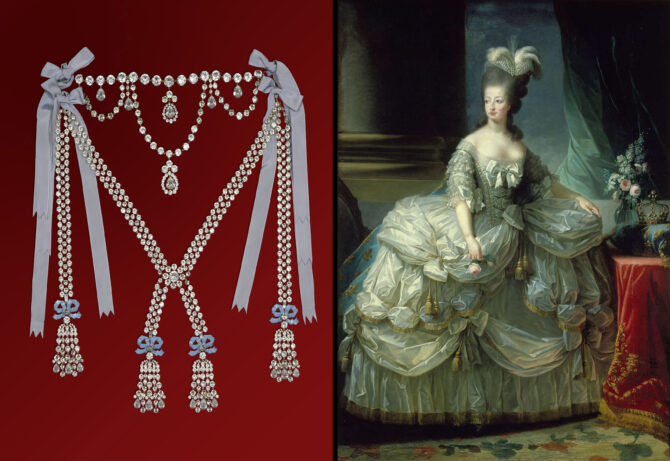

- SUBSCRIBE
- ALREADY SUBSCRIBED?
BECOME A BONJOUR PARIS MEMBER
Gain full access to our collection of over 5,000 articles and bring the City of Light into your life. Just 60 USD per year.
Find out why you should become a member here.
Sign in
Fill in your credentials below.
The diamond necklace scandal which did so much damage to the reputation of Queen Marie-Antoinette just before the French Revolution has been in the news again. For among the treasures auctioned at a recent Sotheby’s Royal and Noble Jewels Sale in Geneva was a necklace believed by experts to contain many of the diamonds from the jewelry which was the talk of Paris in the 1780s. Bidding was fierce and the piece eventually sold for over$4.8 million, more than double the estimated price. The anonymous buyer was said to be “ecstatic” at securing the piece and no wonder. Few pieces of jewelry have such a dramatic story attached to them.
The original necklace contained about 650 diamonds and had been commissioned by Louis XV from the Parisian jewelers Boehmer and Bassenge. The king sought a necklace to “surpass all others in grandeur” as a gift for his mistress, Jeanne du Barry, and his wish was certainly granted. The historian Thomas Carlyle called the piece “a very Queen of Diamonds,” and described it as “a row of 17 glorious diamonds … a three-wreathed festoon, with pendants enough (simple pear shaped, multiple star-shaped, or clustering amorphous) encircling it.” Unfortunately, it was not finished for 10 years, by which time Louis had died and his mistress had been banished from the court. That’s when the connection to Marie-Antoinette began.
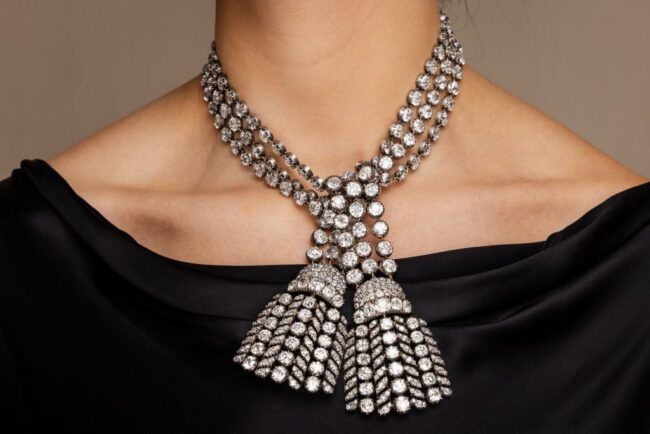
Necklace believed to contain diamonds from the notorious “Affair of the Diamond Necklace.” Photo courtesy of Sotheby’s
The jewelers were naturally anxious to sell the piece which had cost them so much to make and knew that only royalty would be able to afford it, so they consulted with the new king, Louis XVI. It’s said that he offered to buy it for his wife, but that she rejected the offer, feeling it was far too expensive and that the money would be better spent on ships for the navy. How ironic then, that the queen’s connection to the necklace was later used against her as evidence of her extravagance. The story is complex and sometimes shaded in mystery, such that even the respected historian Antonia Fraser has written that “the affair can never be unravelled.”
Much of the unexplained is linked to two shady characters who were key players in the intrigue. One was a scheming plotter, the other a should-have-known-better man of the church who allowed himself to be duped with disastrous repercussions for all involved. The confidence trickster, Jeanne, who styled herself the Countess of La Motte, had family connections to the Valois family (royalty from previous centuries), but had fallen on hard times. She was able to frequent the court only because the king had granted her a small pension and so she was always looking for ways to increase her wealth and influence.
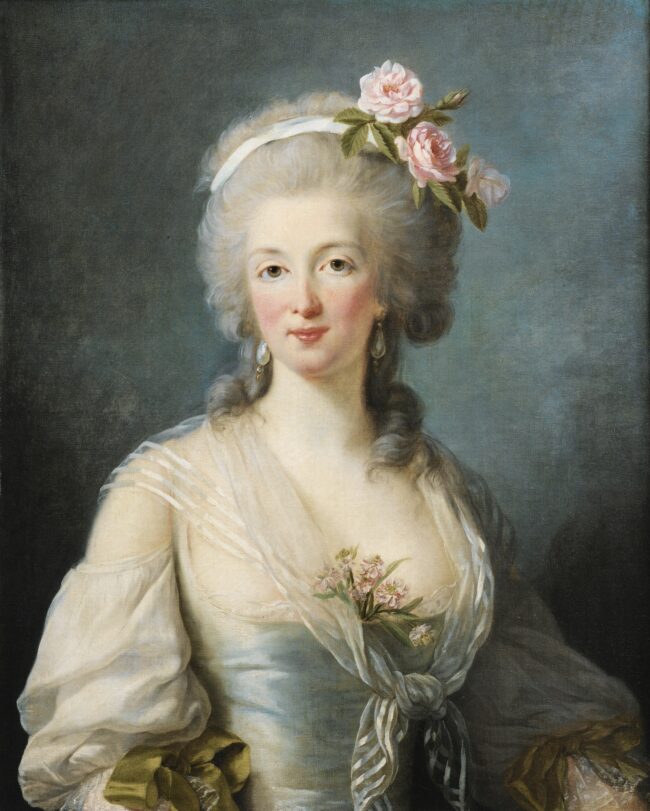
Portrait of Jeanne de Valois-Saint-Rémy (1756-1791) by Élisabeth Vigée Le Brun. Public domain
Cardinal Rohan had a prestigious career behind him, having served as the French Ambassador to Vienna. But he was now excluded from the royal circle because he had openly criticized Marie-Antoinette’s mother, the Austrian Empress Maria Theresa. So, he too was looking for ways to get back into favor at the court and in 1785, when he and the Countess de la Motte began an affair, he was easily persuaded by her claim to be one of the queen’s inner circle and her promise to use her influence on his behalf.
Jeanne de la Motte began bringing the Cardinal forged letters, purporting to be from Marie-Antoinette, which persuaded him that the queen was willing to bring him back into favor. Jeanne went further, arranging for the Cardinal to “meet the queen” late one night in the gardens at Versailles, then sending along a prostitute, Nicole d’Oliva, in disguise. The Cardinal was taken in by this trickery and when another letter arrived, apparently written by the queen, asking him to negotiate with the jewelers and help her buy the fabulous necklace in secret, he readily agreed to do it.

The Palace of Versailles. Photo: Andreas H./ Pixabay
Cardinal Rohan told the jewelers he would pay for the necklace in installments and, delighted to have found a buyer at last, they handed it over to him. It was soon collected by an intermediary, a man claiming to be a royal valet, but who in fact had been sent by the countess and was part of the plot. While the Cardinal presumed the necklace was taken straight to the queen, it was in fact immediately chopped up by the countess and her husband so that they could sell the diamonds on the black market in London and Paris.
The Cardinal was surprised that no letter of thanks for his help arrived from the queen and that she was not soon seen in public wearing her new jewelry. Boehmer and Bassenge meanwhile were disconcerted when the payments did not arrive as agreed and they decided to write to the queen about the necklace they assumed she now owned. Marie-Antoinette destroyed the first letter, assuming that they were just trying again to interest her in jewelry she had already rejected. When the jewelers sent a second letter, investigations were started and the intrigue began to unravel.
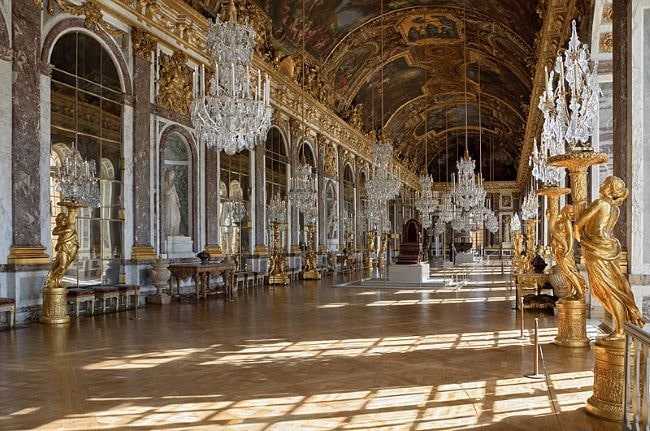
Hall of Mirrors at Versailles. Photo: Myrabella / Wikimedia Commons
One of the first indications that the queen’s letters were forgeries was the signature “Marie-Antoinette de France.” The queen wrote only her baptismal name on official documents, never adding the words “de France.” The Cardinal was much ridiculed for not having spotted this, but this was only the start of his problems. He was very publicly arrested in the Hall of Mirrors at Versailles, just as he was about to celebrate mass, so the accusations against him spread quickly and a scandal ensued. At his trial it was decided he was innocent but had been roundly duped and he was deprived of all his official roles and exiled from the court.
Jeanne Lamotte and accomplices, including both her husband and her lover, were found to have deceived the queen for their own gain and were sentenced to be whipped, branded with a hot iron and then imprisoned for life. Count Lamotte was tried in absentia, having managed to run away, but his wife took the full punishment. Eye-witnesses described the furious struggle she put up as the hot iron approached, resulting in the V for voleuse (thief) marking her breast rather than her shoulder as intended. She was taken to serve her sentence in the prison wing of the Salpêtrière, although she later managed to escape and leave for England where she wrote her Mémoires, including plenty of scathing remarks about the queen.
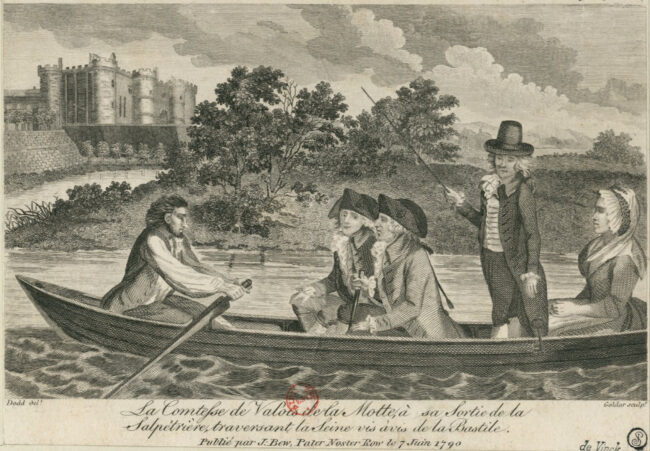
The Countess of Valois de la Motte, leaving Salpétrière prison, crossing the Seine opposite the Bastille. Engraving by John Goldar published on June 7, 1790. Public domain
It was the unfortunate Marie-Antoinette who, despite her innocence, came out worst from it all. The king realized early on how damaging the affair could be for her reputation, saying that “the name of the Queen is precious to me and it has been compromised,” but he cannot have predicted how the general public, already looking for excuses to criticize Marie-Antoinette, would use the diamond necklace affair against her. They saw it as “proof” that she was vain, frivolous, a spendthrift who thoroughly deserved the nickname they devised for her, Madame Déficit. It fueled the idea that she was morally lax, having tried to defraud the state and agreed to unseemly nocturnal meetings, although both these accusations were untrue.
Poor Marie-Antoinette. While it was true that she had in the past spent large sums of money on dresses and other finery, she was innocent of all the other charges. She had not coveted the necklace, but rejected it, she had not written to anyone trying to procure it or attempted to defraud the royal jewelers. She certainly had not agreed to or attended the much-talked about clandestine late-night meeting. Rather, she had been the victim of a plot. But it mattered not, for people had made up their minds. After the diamond necklace affair, the queen began to appear less and less often in public and it would be no exaggeration to say that the scandal contributed to her eventual demise.
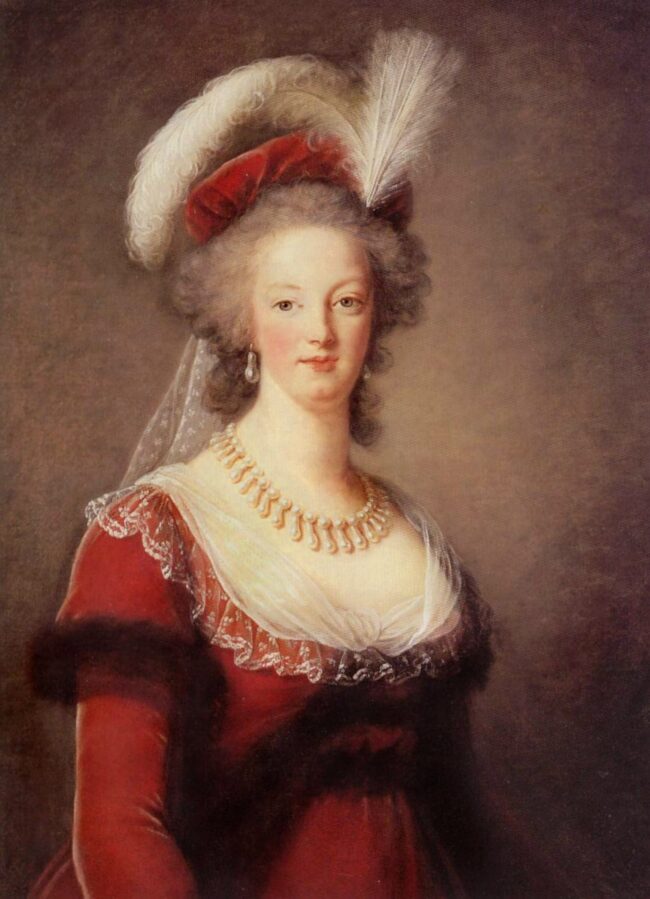
Marie Antoinette portrait by Élisabeth Louise Vigée Le Brun. Public domain
The story lives on. Alexander Dumas based his novel The Queen’s Necklace (1849) on it and writers as diverse as Goethe, Thomas Carlyle and the 20th century novelists Jean Plaidy and Barbara Cartland were all inspired by it. The story encompasses many irresistible factors including wealth, intrigue and a connection to the ultimately tragic story of Queen Marie-Antoinette. In fact, the link is tenuous because the necklace was broken up and its diamonds sold to a number of buyers on the black market. The most that can be said is that experts agree that some of the jewels on the recently sold piece may be originals.
None of this reduced the appeal of the necklace at the recent auction, where interest in it was high and the buyer, who remains anonymous, is said to have bid fiercely to attain it. She paid more than twice the guide price, her determination to own it surely explained by the fascinating story attached to it. As Andres White Correal, chair of the Sotheby’s Jewelry Department explained at the time of the sale, “people are not only buying the object, but they’re buying all the history that is attached to it.” And, in this case, what a history!
Lead photo credit : The Queen's necklace, reconstruction in zirconia, Château de Breteuil. Wikimedia commons


